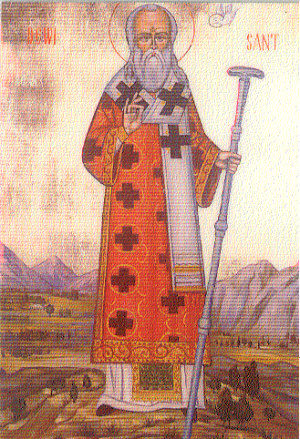Saint David, Patron Saint of Wales
March the 1st is Saint David’s Day. Saint David, or Dewi as he is known in Wales, was canonized by Pope Callactus II in 1120AD and March 1st the date of his death, was added to the Church calendar as his feast day. It was said that two Pilgrimages to his Cathedral were equal to one to Rome and three equaled one to Jerusalem.
My memories of Saint David’s Day include the girls in their National Dress and us boys going to school with a Leek pinned to our clothes. A real, smelly Leek and sometimes there would be a prize for the largest Leek. Being young boys the Leeks didn’t last. During the day we would all be nibbling away until, by the time we went home there would be nothing left except a sorry looking root.
All my memories of Saint David’s Day are happy ones, both as a child and as an adult where I could enjoy the day with my children. All, that is, except for 1979 when Wales rejected devolution by an overwhelming majority. That was heartbreaking for me. That was the occasion when one of my heroes, Neil Kinnock, betrayed his country, his party and the Welsh working class.
The saint David’s Day concert that my mother would never let me forget took place at the local Chapel. I was eight years old and stood in front of the audience to recite a poem. I do not remember what the poem was and I didn’t remember it then. My mind went a sudden blank. So I improvised, I recited a rhyme my grandfather had taught me about a Beetle, a coal mine, father getting drunk and mother shouting. I bowed as I had been taught, the crowd erupted in delight and my mother and grandmother tried to sink into their seats denying all knowledge of me.
So who was Saint David? And why would the Welsh have a Leek as their national emblem?
The Welsh National Dress

Saint David

In the South West corner of Wales, stands the small city of Saint David’s. The Cathedral of Saint David stands on the grounds of the Monastery he founded. His father was Sandde, a son of Ceredig, King of Ceredigion. His mother was Non daughter of Lord Cynyr of Caer Goch. At the site of his birth is Capel Non, “The Chapel of St Non” near the city of St David’s. He was educated at the monastery of “Hen Fynyw” in the area of Whitland, Carmarthenshire. His educator was an old blind monk, Paulinus, who himself was to be canonized. He stayed there many years and then ventured forth as a missionary. Preaching Christianity to the pagan tribes, he founded churches all over Britain, including it is said, Glastonbury Abbey. At Glastonbury he donated a travelling altar containing a large sapphire. This was one of the items Henry VIII confiscated during the decommissioning of the Monasteries. Some say the sapphire is among the crown jewels today. He journeyed to Jerusalem and was ordained ArchBishop of Wales by the Patriarch of Alexandria. On his return it is said that one of the great miracles of his life occurred. A synod was called at Llanddewi Brefi to confirm his position as ArchBishop. A large congregation was in attendance and those at the back could not see or hear him. It is said that the ground rose up under him so that he stood on a mound for all to see and hear.
His philosophical contribution to Christianity lay in his opposition to the Pelagian heresy. In the 5th century a British Monk named Pelagius travelled to Rome and preached that perfection was possible for anyone, that salvation came from living a Christ-like life and that the atonement of Christ was only for the weak. He held that there was no “Original Sin” only “Original Blessings” This view became accepted by many high born Christian rigorists even though it was opposed by such persons as Saint Augustine who said that this doctrine denied the need for grace.
Dewi opposed this doctrine amongst the Welsh and chaired what became known as “The Synod of Victory” Where Pelagian views were put outside the official doctrine of the church in the British Isles.
The chorus says. "After the work of everyone and everything, we are still here" Yma O Hyd.
Why, of all things, would he be remembered by a Leek?
During the 5th century the Germanic tribes of Angles, Saxons, Jutes and Danes invaded the island. To them the indigenous British were “Wealeas” A word that means Stranger or Foreigner. The word that today we know as Welsh and the Country is Wales. In those days Wales was anywhere the English were not. In fact for a long time Wales was anywhere north of Watling Street. Due to the time frame Dewi has sometimes been associated with Arthur of Welsh legend. The historical basis for Arthur probably lay in the Celtic warlord who was able to unite the tribes in opposition to the Saxon advance. The last of the great battles he fought was at “Mons Badonicus” near the ancient city of Bath, known in Welsh as “Caer Fadon” prior to the battle; Dewi had arrived to bless the army. It was mentioned to him that a mist was likely to rise over the battlefield and there would be difficulty distinguishing friend from foe. Dewi told them that on his way there he had seen a field of Leeks. He suggested that everyone should wear a Leek pinned to their clothes so they could recognize each other on the field of battle. This was done and the Welsh won a resounding victory. The Saxon advance was halted for a whole generation. It is said that Arthur, at that battle, “Carried the Cross of our Lord” for three days. No doubt this meant that he wore a cross on his clothes and it inspired a 9th century poet to write; “A lluman glân Dewi a ddyrchafant” “And they will raise the pure banner of Dewi”
From that time forward, on March 1st, the anniversary of Saint David’s death, Welshmen everywhere wear a Leek on their clothes. So that wherever we may be, we can recognize a fellow countryman. Though these days, we grown-ups wear an imitation leek instead of the real thing.
The Saxon advance was not finally halted however and at the battle of Dyrham in 577AD the invaders won a decisive victory. The British were forced to surrender the prosperous cities of Bath, Gloucester and Cirencester. From this point on they were pushed further west into the regions of Cumbria (The Lake District) Cornwall and Wales where the language and culture still survive.

Saint David, or Dewi, is believed to have died on March 1st 489 AD at his monastery. It is said that the monastery was filled with Angels celebrating his passing. Just before his death he made a speech including words that have come down to us through the centuries.
“Arglwyddi brodyr a chwiorydd, cadw dei’ch ffydd a’ch cred a fyddwch ffyddlon yn y pethau bach.”
“Noble brothers and sisters keep your faith and your religion and be faithful in the little things.”
Happy Saint David’s day.










